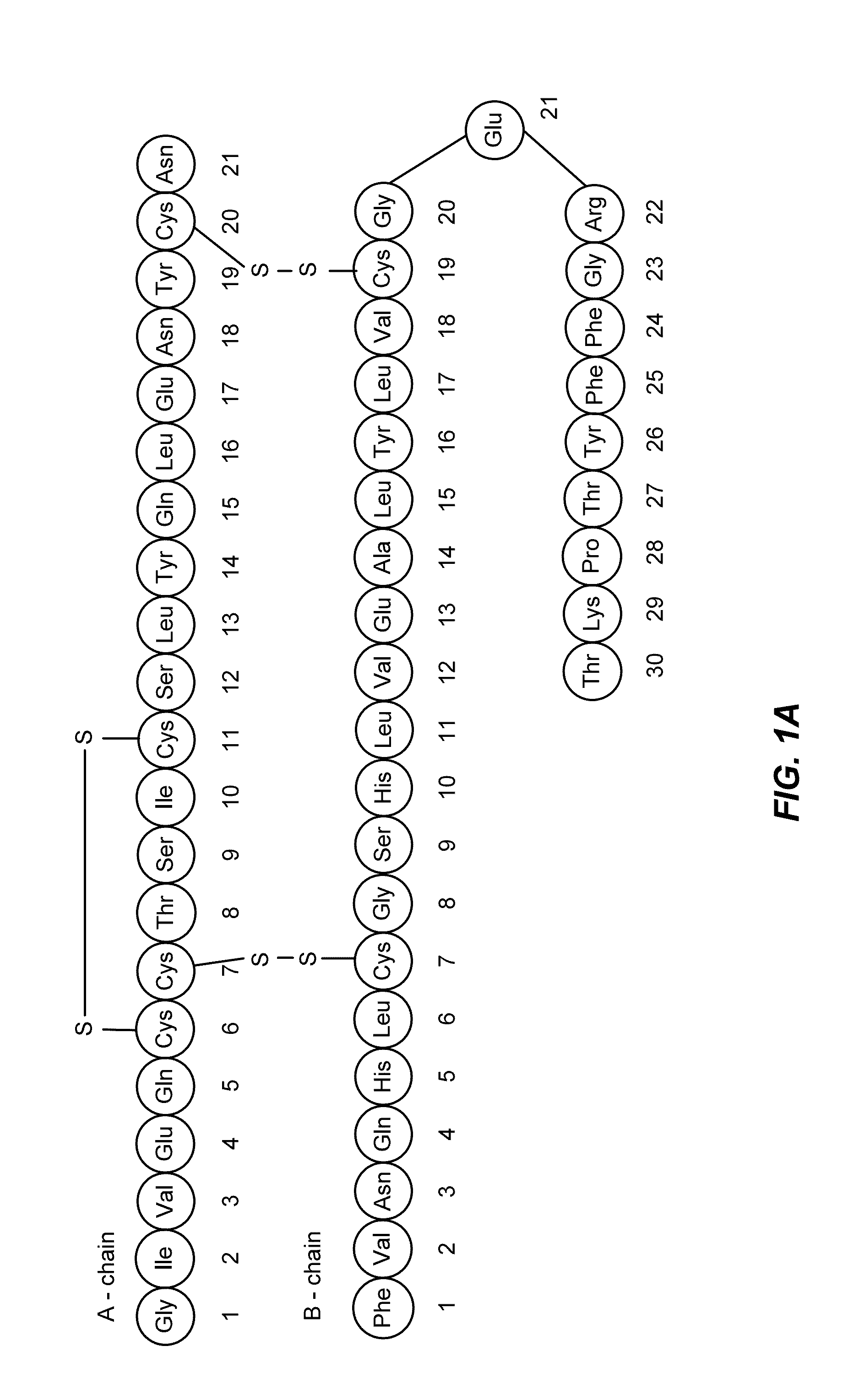Chemically and thermodynamically stable insulin analogues and improved methods for their production
a technology of chemically and thermodynamically stable insulin and analogues, which is applied in the field of recombinant vector constructs and recombinant production of single-chain insulin analogs, can solve the problems of limited stability of conventional insulin preparations, impose hardships on users, and leave the more fundamental and urgent needs of the developing world patients largely unmet, and achieves enhanced stability and purity. high, low cost
- Summary
- Abstract
- Description
- Claims
- Application Information
AI Technical Summary
Benefits of technology
Problems solved by technology
Method used
Image
Examples
example 1
[0108]Cloning and Expression of Single Chain Insulin (SCI) DNA in E. Coli
[0109]Cells are induced to initiate the synthesis of KSI-SCI with 1 mM IPTG (Invitrogen) and 0.2% L-arabinose (Calbiotech) as follows. Plated cells are incubated overnight at 37° C. and then one colony from this plate is grown up overnight in a starter culture of 8 mL of Luria broth+ampicillin. The following morning, the starter culture is inoculated into 1 L of Luria broth+ampicillin and grown to an optical density (OD) of 0.5. At this point, the cells are induced with 1 mM IPTG (Invitrogen) and 0.2% L-arabinose (Calbiotech) to initiate the synthesis of KSI-SCI.
[0110]To optimize the amount of KSI-SCI production in the bacteria, samples of the 1 L inoculation are taken prior to inducing the bacteria, and then 2, 4, 6, and 16 hours (overnight growth) after induction. An acrylamide gel is used to analyze the samples.
[0111]Eight hours after induction, the cells are re-induced with the same concentrations of IPTG ...
example 1a
[0112]The construct is re-designed to place a His-tag upstream from the KSI sequence rather than downstream.
example 2
[0113]Following induction of KSI-SCI production in E. coli, lysis buffer containing 25 mM Tris pH 8.0, 50 mM NaCl, 10% glycerol, and the protease inhibitor 1000× PMSF is added before lysis. Insoluble inclusion bodies are collected using washing and centrifugation. Three different wash buffers are used containing varying concentrations of Tris pH 8.0, NaCl, and Triton X100. Once washed clean of the remaining cellular components, the insoluble inclusion bodies are solubilized in a buffer containing 25 mM Tris pH 8.0, 50 mM, NaCl, 0.1 mM PMSF, and 8M urea. The 8M urea serves as a chaotropic agent necessary in solubilizing protein.
[0114]An acrylamide gel is run on both uninduced and induced bacteria, the cell lysate produced from high output sonication, and the supernatant from each washing step during the inclusion body preparation. The gel is stained with Coomassie Blue reagent. The appearance of a band in the induced sample provides evidence for inclusion body synthesis resulting fro...
PUM
| Property | Measurement | Unit |
|---|---|---|
| temperatures | aaaaa | aaaaa |
| affinity | aaaaa | aaaaa |
| chemical degradation resistance | aaaaa | aaaaa |
Abstract
Description
Claims
Application Information
 Login to View More
Login to View More - R&D
- Intellectual Property
- Life Sciences
- Materials
- Tech Scout
- Unparalleled Data Quality
- Higher Quality Content
- 60% Fewer Hallucinations
Browse by: Latest US Patents, China's latest patents, Technical Efficacy Thesaurus, Application Domain, Technology Topic, Popular Technical Reports.
© 2025 PatSnap. All rights reserved.Legal|Privacy policy|Modern Slavery Act Transparency Statement|Sitemap|About US| Contact US: help@patsnap.com



